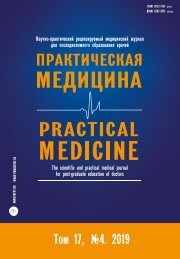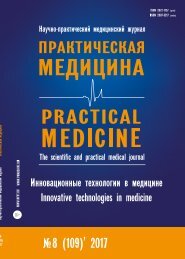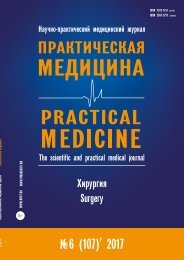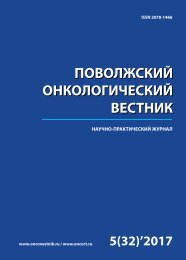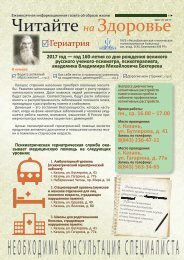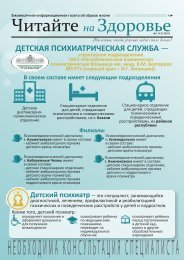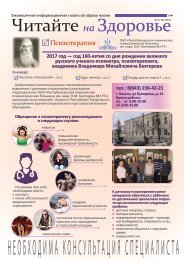ПОВ 4 оранж новый
Create successful ePaper yourself
Turn your PDF publications into a flip-book with our unique Google optimized e-Paper software.
<strong>ПОВ</strong>ОЛЖСКИЙ<br />
ОНКОЛОГИЧЕСКИЙ<br />
ВЕСТНИК 4(31)’2017<br />
Выводы. Заболеваемость ЗНО населения Юго-Восточного региона выросла за 2006-2016 гг на 54,3%, и составила<br />
426,4 0 / 0000<br />
— в 2016 году. Темп роста заболеваемости в ЮВР в 1,5 раза выше, чем в целом по республике. При прочих<br />
равных условиях следует ожидать дальнейший рост заболеваемости ЗНО. Прогнозируемое значение заболеваемости<br />
в 2019 году должно составить 482,0 0 / 0000.<br />
За рассматриваемый период произошло существенное снижение доли заболевших<br />
злокачественными новообразованиями в возрасте 70-79 лет — на 9,4%. Максимальный рост количества заболевших<br />
отмечен в возрастной группе 60-69 лет (на 7,3%). Возрастная группа 70-79 лет характеризуется максимальным снижением<br />
доли заболевших, как среди мужчин, так и среди женщин. Темп убыли составил 8,6% и 10,4% соответственно. Перераспределение<br />
ранговых мест в структуре онкологической заболеваемости населения ЮВР за 2006-2016 гг. произошло за<br />
счет трахеи, бронхов и легкого — на 2,1%, доли рака молочной железы — 1,21%, прямой и ободочной кишки — на 0,5%.<br />
К наиболее существенным изменениям структуры онкологической заболеваемости следует отнести снижение доли рака<br />
желудка — на 3,4% и рост доли рака предстательной железы — на 5,23%. В среднесложившейся структуре заболеваемости<br />
злокачественными новообразованиями населения Юго-Восточного региона республики за период с 2006 по 2016 гг. три<br />
первые позиции занимают рак кожи (с меланомой) — 11,7%, колоректальный рак (11,6%) и рак молочной железы (11,2%).<br />
Ключевые слова: Юго-Восточный регион Татарстана, заболеваемость, структура опухолевой патологии.<br />
Abstract<br />
Introduction. The problem of providing specialized cancer care is one of the most pressing for national health care. High and<br />
constantly increasing rates of morbidity, mortality, malignancy, disability, reduced quality of life and the associated substantial<br />
socio-economic damage undoubtedly dictates oncologists and health care managers to maintain an ongoing research in this area.<br />
Objectives of the study. In the framework of the present study has investigated trends, patterns and structure of morbidity of<br />
malignant tumors of the population of the South-Eastern region of Tatarstan Republic of according to gender, age and region of<br />
residence.<br />
Results. Given the attached of the city’s population was 648 162 people. For the period from 2006 to 2016 in SER RT was 20 787<br />
cases of cancer, which corresponds to an average registration of 2 thousand patients a year. In General, the absolute number of<br />
cancer patients in the South-Eastern region of Tatarstan increased by 48.0 per cent during the reporting period. It may be noted<br />
that in the dynamics of the structure of oncological morbidity of the adult population of the South-East region there has been a<br />
significant decline in the share of the following malignant neoplasms: of stomach by 3.42%, trachea, bronchus and lung — 2.1%.<br />
Slight decline in the proportion of breast cancer is 1.21% and the rectum and colon by 0.5%. On the same level have the same percentage<br />
of malignant tumors of the cervix (2,75%), lymphomas (1,76%). Medium structure of morbidity with malignant neoplasms<br />
of the population of the South-Eastern region of the Republic during the period from 2006 to 2016. as follows: first rank position is<br />
skin cancer (melanoma) — 11,7%, ranking second place — colorectal cancer (11.6%), the third rank is the position of breast cancer<br />
(11.2%).<br />
Conclusions. The incidence of malignant tumors of the population of the South-East region increased over the 2006-2016 54.3%<br />
and amounted to 426,4 0 / 0000<br />
— in 2016. The growth rate of incidence in SER 1.5 times higher than in the whole country. Ceteris<br />
paribus, we should expect further increase in the incidence of cancer. The predicted value of disease in 2019 should be of<br />
482.0 0 / 0000<br />
. During the period under review, there was a significant decline in the proportion of cases of malignant neoplasms<br />
in the age of 70-79 years is 9.4%. The maximum increase in the number of cases observed in the age group 60-69 years (7.3%).<br />
Age group 70-79 years — is characterized by a maximum decrease in the share of cases among men and among women.<br />
The pace of decline was 8.6% and 10.4%, respectively. Redistribution ranking positions in the structure of oncological morbidity of<br />
the population SER for 2006-2016 was due to trachea, bronchus and lung — 2.1%, the proportion of breast cancer is 1.21% and the<br />
rectum and colon by 0.5%. The most significant changes in the structure of cancer incidence should be attributed to the decline<br />
in the proportion of stomach cancer by 3.4% and share growth of prostate cancer by 5.23%. Weighted average in the structure of<br />
malignant neoplasms in population of the South-Eastern region of the Republic during the period from 2006 to 2016 the first three<br />
positions in skin cancer (melanoma) — 11.7%, colorectal cancer (11.6%) and breast cancer (11.2%).<br />
Key words: South-Eastern region of Tatarstan, morbidity, structure of tumor pathology.<br />
Введение<br />
Проблема оказания специализированной онкологической<br />
помощи является одной из актуальных<br />
для отечественного здравоохранения. Высокие и<br />
постоянно растущие показатели заболеваемости,<br />
смертности при злокачественных новообразованиях,<br />
инвалидизация, снижение качества жизни и связанный<br />
с этим значительный социально-экономический<br />
ущерб несомненно диктует онкологам и организаторам<br />
здравоохранения вести постоянные исследования<br />
в этой области. Несмотря на реально ощутимый<br />
прорыв в изучении биологии рака, поиска и широкого<br />
внедрения новых лекарственных противораковых<br />
препаратов, методов ранней диагностики, новых<br />
высокотехнологичных методов лучевого и хирургического<br />
лечения, вопросы доступности и качества<br />
специализированной онкологической помощи для<br />
населения страны остаются открытыми и нерешенными<br />
[1, 6-10].<br />
С.А. Карамаликов и соавт. Анализ заболеваемости злокачественными новообразованиями взрослого населения ...<br />
11




